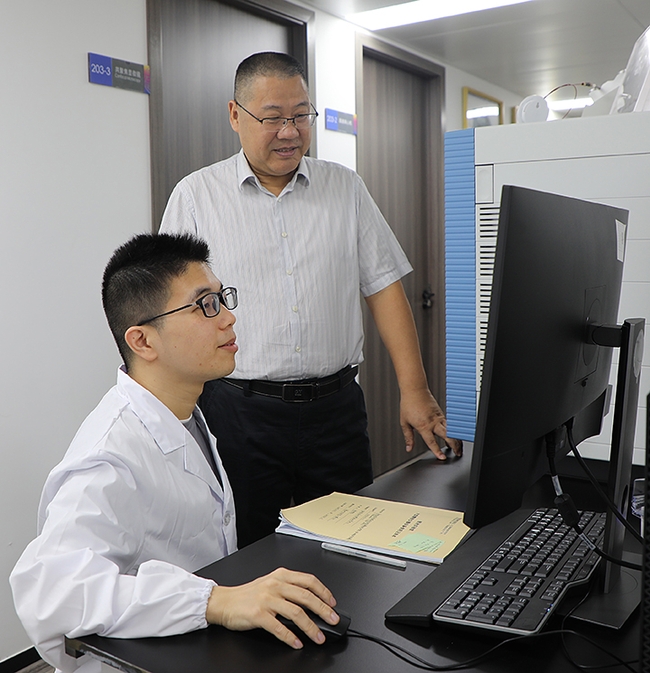- Author: Kathy Keatley Garvey
Doctoral student Ching-Jung Lin of the laboratory of nematologist Shahid Siddique, associate professor, UC Davis Department of Entomology and Nematology, is the recipient of a two-year, $32,000 Ministry of Education Taiwan Government Scholarship to Study Abroad (GSSA).
The scholarships are awarded to young Taiwanese doctoral students in various fields to support their research.
Lin enrolled in the UC Davis plant pathology doctoral program, with a designated emphasis in biotechnology, in 2020. In the Siddique lab, she is working on nematode transformation and nematode-induced plant immunity.
Lin received her bachelor's degree in agronomy in 2015 from the National Chung Hsing University, Taichung, Taiwan, and her master's degree in plant biology in 2018 from National Taiwan University, Taipei, Taiwan. Her master's research, in the lab of Chiu-Ping Cheng, involved the study of tomato innate immunity mediated by bacterial-wilt-associated QTL (quantitative trait locus) genes. Before joining the Siddique lab, she was a research assistant in the lab of Erh-Min Lai of Academic Sinica, where she studied Agrobacterium-triggered immunity in Arabidopsis.
“I am fascinated by plant-microbe interaction,” Lin says. ‘Currently I am interested in the development of functional genetic tools in plant-parasitic nematodes and the characterization of nematode-induced plant immunity.
A frequent presenter at conferences, Lin presented her research at the 2023 Bay Area Worm meeting at UC Davis; the 2019 International Society for Molecular Plant-Microbe Interactions (IS-MPMI) Congress in Glasgow, and at several Taiwanese conferences. She will compete in a 12-minute presentation competition at the 62nd annual Society of Nematologists' meeting, to be held July 9-14 at The Ohio State University, Columbus. She received a $600 Bayer Crop Science Student Travel Award to attend the conference.
Lin also presented at the 2019 at International Society for Molecular Plant-Microbe Interactions (IS-MPMI) Congress in Glasgow, and at several Taiwanese conferences.
Plant-parasitic nematodes are destructive pests causing losses of billions of dollars annually. Siddique says the research in his lab “focuses on elucidating interactions between plant parasitic nematodes and their hosts using molecular and applied methodologies.”

- Author: Kathy Keatley Garvey
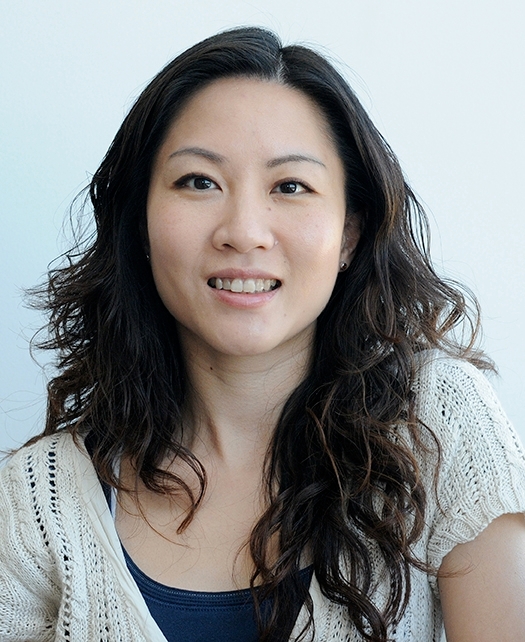
"I am pleased Joanna Chiu has been appointed as the chair of the Department of Entomology and Nematology," said Helene Dillard, dean of the UC Davis College of Agricultural and Environmental Sciences. "She is an outstanding scholar and teacher with demonstrated leadership skills. I look forward to watching Professor Chiu thrive in her new role as chair and seeing the department continue to flourish.”
The new vice chair is community ecologist and associate professor Rachel Vannette, and the new Entomology Graduate Program chair, replacing Chiu, is community ecologist and professor Louie Yang.
Other women scientists who have chaired the department: Professor Diane Ullman, 2004-05, and interim chair, Lynn Kimsey, 2008-09.
Chiu joined the Department of Entomology and Nematology in 2010 as an assistant professor, and advanced to associate professor and vice chair in 2016, and to professor and vice chair in 2021. She was named one of 10 UC Davis Chancellor's Fellows in 2019, a five-year honor awarded to associate professors who excel in research and teaching. The UC Davis Academic Senate honored her with a Distinguished Teaching Award, Graduate/Professional category, in 2022. She most recently received the Chancellor's Award for Excellence in Mentoring Undergraduate Research.
Chiu co-founded and co-directs (with professors Jay Rosenheim and Louie Yang) the campuswide Research Scholars Program in Insect Biology, launched in 2011 to provide undergraduates with a closely mentored research experience in biology. The program's goal is to provide academically strong and highly motivated undergraduates with a multi-year research experience that cultivates skills that will prepare them for a career in biological research.
A native of Hong Kong and a first-generation college student, Joanna received her bachelor's degree, magna cum laude, in biology and music from Mount Holyoke College, Mass., and her doctorate in molecular genetics in 2004 from New York University, New York. She trained as a postdoctoral fellow from 2004 to 2010 in molecular chronobiology at the Center for Advanced Biotechnology and Medicine, at Rutgers, the State University of New Jersey. Her postdoctoral training was funded by an NIH F32 Ruth L. Kirschstein National Research Service Award postdoctoral fellowship and K99/R00 Pathway to Independence Award.
"I grew up not knowing any scientists,” she related. “Both my parents work in the financial industry and neither went to college. However, my dad loves the outdoors and my childhood memories includes snorkeling with my dad and siblings, hiking in the very limited outdoors in my native Hong Kong, and watching a lot of National Geographic on TV. As a result, I have always been curious about biology, especially animal behavior. I really hoped to study biology in college. My parents, on the other hand, wanted me to be a doctor."
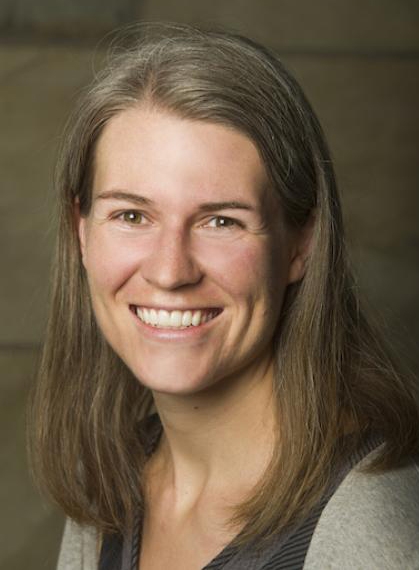
Vannette joined the UC Davis Department of Entomology and Nematology in 2015 after serving as a postdoctoral fellow at Stanford University's biology department. As a Gordon and Betty Moore Foundation Postdoctoral Fellow from 2011 to 2015, she examined the role of nectar chemistry in community assembly of yeasts and plant-pollinator interactions.

Yang, a native of Australia, but who grew up in West Virginia, received his bachelor's degree in biology from Cornell University, magna cum laude, in 1999, and a doctorate in population biology from UC Davis in 2006. He received the University of California President's Postdoctoral Fellowship to train with Professor Jonathan Levine (UCSB) and Professor Mary Power (UCB). He joined the UC Davis Department of Entomology and Nematology as an assistant professor in 2008, advanced to associate professor in June 2015, and to professor in July 2021. Yang is highly regarded for his research and mentoring. He received the 2017 Eleanor and Harry Walker Academic Advising Award, the 2018 NACADA international Outstanding Faculty Academic Advising Award, and the 2023 Distinction in Student Mentoring Award from the Pacific Branch, Entomological Society of America.
The Department of Entomology at UC Davis began as an offshoot of the Department of Entomology and Parasitology at UC Berkeley and the two were closely entwined for more than 50 years before the UC Davis Department of Entomology became autonomous on July 1, 1963. The department now has 24 faculty, plus a lecturer.
UC Davis offered a two-year non-degree program in entomology, beginning in 1913. The first degree in entomology provided at UC Davis was in 1923-24 at which time Stanley B. Freeborn (for whom Freeborn hall was named) was transferred from UC Berkeley to UC Davis to head the program. (See https://entomology.ucdavis.edu/entomology-history)
The UC Davis Department of Nematology officially joined the Department of Entomology on May 28, 2013.
- Author: Kathy Keatley Garvey
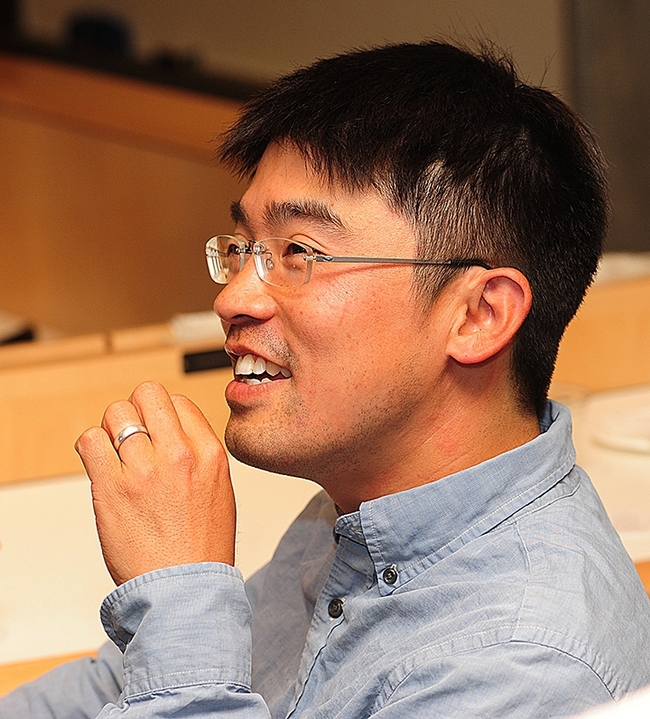
The article, “Complexity, Humility and Action: A Current Perspective on Monarchs in Western North America,” is “meant to provide a concise review of and perspective on recent western monarch research,” Yang said.
The western monarch population overwinters along the California coast. Estimated at 4.5 million in the 1980s, it has dropped significantly over the past five years, the professor related, noting an “86% single-year population decline in 2018, an overwintering population of less than 2000 butterflies in 2020, and an unexpected >100-fold increase in 2021."
Yang defined the western monarch population as occupying "a geographically distinct region of North America west of the Rocky Mountain...Ongoing climate change has made the western monarch range warmer, drier, and more prone to heatwaves, wildfires, and winter storms with complex effects on their ecology. Land development and changes in the structure of landscape mosaics have modified both the breeding and overwintering habitats of western monarch butterflies, changing the spatial distribution of resources and risks across their range. Shifts in agricultural and horticultural practice have changed the nature of potentially deleterious chemicals in the environment, including novel herbicides and insecticides."
Yang said the spread of non-native milkweed species has likely had both positive and negative consequences for western monarchs, and more research is needed.
His three suggestions:
- "First, we should continue to support both basic and applied monarch research. This includes efforts to better understand fundamental aspects of monarch biology, studies to examine the ecological factors that limit monarch populations in the West and efforts to improve more targeted adaptive management and monitoring efforts. Basic research in monarch biology and ecology improves our understanding of this complex system and can inform conservation actions in profound and unexpected ways. In turn, applied research can address recognized gaps in knowledge that would otherwise limit available strategies for conservation planning and management."
- "Second, recognizing the limits of our current understanding, we should follow the precautionary principle to minimize the risk of counterproductive action. The complexity of this system makes it difficult to anticipate or assume future changes in behavior, species interactions or population dynamics. In practice, this may mean prioritizing efforts to better understand and facilitate existing mechanisms of ecological resilience and recovery over direct actions to manipulate or augment the population with less certain consequences. More broadly, this approach would probably emphasize common sense approaches to mitigate the widely recognized upstream drivers of global change (e.g., climate change and land use change), rather than those requiring a detailed understanding of their complex, interactive effects on species-specific ecologies further downstream."
- "Third, we should work to improve, protect and maintain the resources required throughout the complex monarch life cycle. In part, this likely means prioritizing conservation efforts that target the times and places that are likely to have the greatest positive effects, building on the common ground of available science. In the case of western monarchs, this includes protecting current and future overwintering habitats, the resources required for population expansion in the early season, and the resources required for the fall migration. Recognizing the potentially widespread and pervasive effects of pesticides, this could also mean efforts to develop more ecologically realistic and relevant metrics for the regulation of environmental chemicals."
Yang opined that "In the broader context, many of the drivers that are contributing to western monarch population declines are likely to also be affecting other species. In turn, many of the strategies that would support monarch conservation would likely benefit other species, and many of the strategies that would benefit other species are likely to also support monarch conservation. As we build on currently available science to better understand and protect the western monarch population, it is imperative that we continue to grapple with the inherent complexity of this system and respond with appropriate humility and necessary action."
Among the 54 scientific publications that Yang referenced was a research article co-authored by UC Davis Distinguished Professor Art Shapiro, who has studied butterfly populations in Central California since 1972. The article, "Fewer Butterflies Seen by Community Scientists across the Warming and Drying Landscapes of the American West," published in Science in March 2021, covered data from the Shapiro transect, the North American Butterfly Association (NABA) community count data and the iNaturalist community observation data. The study observed widespread declines across 450 butterfly species, including the monarch butterfly, in the American West. The authors estimated a 1.6 percent decrease in overall butterfly abundance each year over a 42-year period from 1977 to 2018.
Editors of the journal, Current Opinion in Insect Science, describe it as "a new systematic review journal that aims to provide specialists with a unique and educational platform to keep up–to–date with the expanding volume of information published in the field of insect science."
Yang's research is supported by a National Science Foundation award. He was a guest on National Public Radio's Science Friday in February 2022. Listen to the interview here.
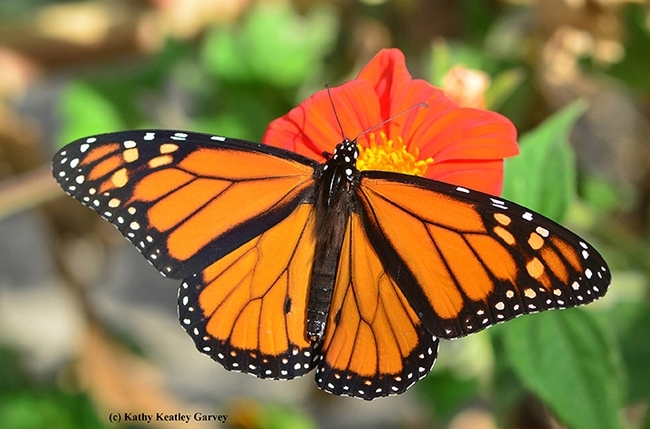
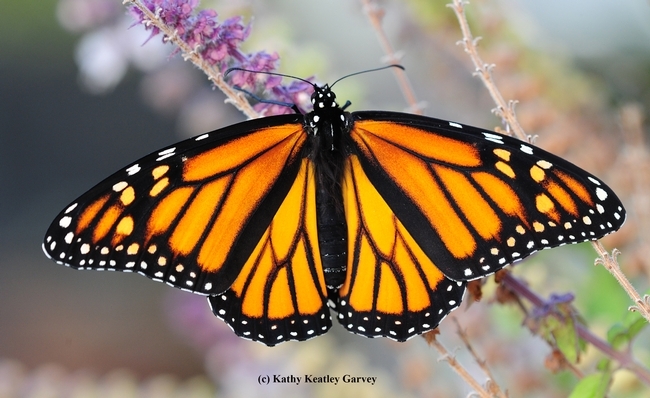
- Author: Kathy Keatley Garvey

Katherine "Katie" Hostetler was named the Outstanding Senior in Entomology; Morgan Myhre, Citation for Outstanding Performance in Entomology: and Kenny Ruiz, Outstanding Senior Award and Departmental Citation in Animal Biology.
Katie Hostetler, Outstanding Senior in Entomology
A member of the Research Scholars Program in Insect Biology (RSPIB), Katie, working in a Center for Watershed Sciences lab, selected as her research project: amphipod shredding behavior impacting algal growth in aquatic systems.
Professor Sharon Lawler, an aquatic entomologist who retired in January from the Department of Entomology and Nematology, nominated her for the award. Lawler worked with her through RSPIB, which aims to provide undergraduates with closely mentored research in biology. "She participated in graduate student Kyle Phillip's project on how wetland plant decomposition supports aquatic food webs in the Sacramento-San Joaquin Delta (Suisun Marsh)," Lawler related. "Katie rapidly became an essential member of the research team, which included John Durand as a principal investigator and Kyle's co-advisor."
"Katie learned numerous techniques in aquatic ecology," said Lawler. "She ultimately designed and led her own laboratory experiment on how amphipods contribute to nutrient recycling in wetlands through shredding and consuming different kinds of detritus. She is working on a draft manuscript for a peer-reviewed journal stemming from her work. "
Durand, a UC Davis estuarine and wetland ecologist, and a faculty member of the Center for Watershed Sciences, related that "Katie has been an outstanding scholar in my research group. She quickly mastered the basic skills needed to support our research, and then collaborated closely with Kyle in his research, eventually designing and executing her own study, which is publishable research. She has maintained an active presence in the lab, and has been consistently available to support other researchers in the lab with zooplankton and invertebrate analysis, and water quality analysis. She is currently working with me and others to develop a flow-through automated zooplankton analysis system using digital photography, a flow cytometer, and machine learning. All in all, Katie is exactly the kind of student we want to honor and encourage as an outstanding senior."
Katie, born in La Jolla and raised in Encinitas, Calif., is a 2019 graduate of San Dieguito High School Academy. She remembers nurturing an early interest in entomology. "I enjoyed gardening with my mom and picking up snails, isopods, and other creatures while playing in the dirt. I also volunteered at the local botanical garden in high school, which confirmed my interest as I got to hang out with insects while gardening!"
She plans to remain in Davis "and continue working at the Center for Watershed Sciences in invertebrate research!"

Co-nominators were Ian Grettenberger, UC Cooperative Extension entomology specialist and assistant professor Department of Entomology and Nematology, and associate professor Christian Nansen, who specializes in applied insect ecology, integrated pest management and remote sensing.
"Morgan is an exemplary student research assistant and has been integral to us accomplishing our research goals," Grettenberger said, adding "She has often gone above and beyond the expectations of the position, even going out of her way to keep data and equipment organized. She is the type of research assistant that thinks ahead to do tasks even better than whatever instructions she was given. She thinks critically and operates very independently. She is also an excellent student and her work in our lab and 'job' as a student is all on top of being a parent as well."
Morgan was a student in Nansen's ENT110 course last fall. "She has been an active member of my informal scientific writing club," Nansen said. Under his mentorship, she is working on writing a journal review article. "She has a lot on her plate and seems to handle everything in very fine style."
Morgan, born and raised in San Diego, said her educational journey followed a nontraditional path. WIth very limited high school experience due to a severe illness, she began attending Palomar Community College at 16 years old. While in community college, she worked at the San Diego Zoo Safari Park and had her two children, Galileo and Esmerelda.
Morgan traces her love of insects to her early childhood. In elementary school, she frequently brought ladybugs into the classroom in her pockets and established a worm club with her friends. Knowing she wanted to become a science teacher, she decided to major in the science subject that most interested her—entomology. While at UC Davis, she discovered a love for agriculture and integrated pest management.
Morgan currently works as a math and science tutor at Pioneer High School and as an undergraduate research assistant in the Grettenberger lab at UC Davis. She plans to obtain her science teaching credentials and master's degree in education and to "continue exploring my love for entomology by introducing my future students to the subject."

Forensic entomologist Robert "Bob" Kimsey of the Department of Entomology and Nematology, who advises the Animal Biology program, described Kenny as "the soul of intelligent self-sufficiency."
"He does not present unsolved problems to others, he invariably presents solutions," Kimsey said. "When he listens he actually hears you, not what he wants to hear. Sufficient unto himself he is also the best possible team member, and is among the hardest working persons I have ever met- he will get the job done! I wish him all possible success in graduate school!"
Kenny, a first-generation transfer student, grew up in Salinas and upon graduating from high school, joined the Marines, serving four years. He received an associate of arts degree in biology from Gavilan College, Gilroy, Santa Clara County, in 2020.
What sparked his interest in his field? "It was while I was doing Muay Thai in Thailand that I found a brochure for an elephant sanctuary that advertised no riding and 'cruelty free.' I didn't know about elephant riding and how cruel and abusive it is to the elephants."
Kenny plans to pursue a career in animal behavior research and conservation. He is applying to the animal behavior master's program at the University of Sussex in England.
Other entomology and animal biology majors who received awards at the Class of 2023 commencements:
Departmental citations: Tranh Than and Stephen Jee
Animal Biology:
Departmental Citations: Yuanyang Liu, Maria Peshkoff, Genevieve Marie Shane, and Ashley Uyehara
Outstanding Performance Citations: Myles Bailey, William Claflin, Sterling Ickes, Sarah Kim, Emma Elizabeth Lauth, Xintong Li, Sarah Kaori Nelson, Karen Vazquez, Sonyia Ying-Rou Williams, Alex Biyang Zhao, Lindsey Anne Campbell
The commencements are online.
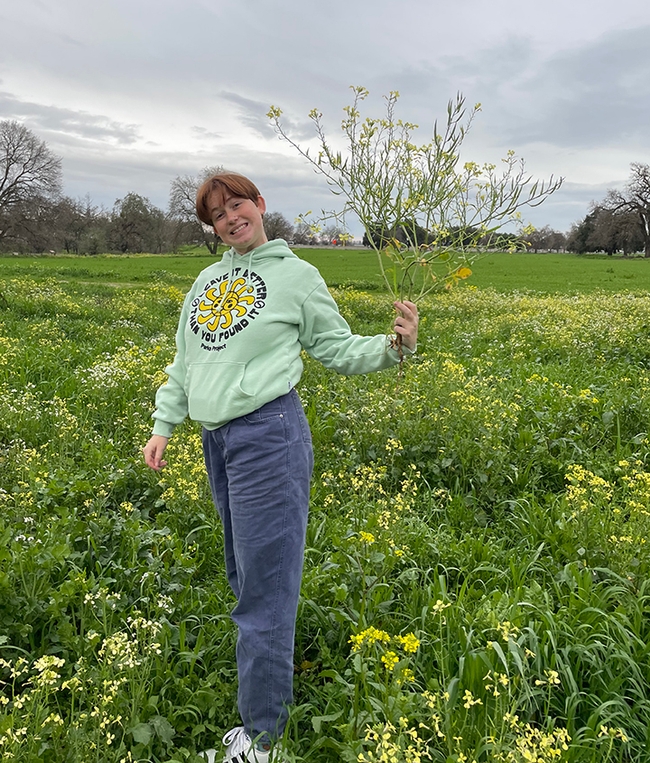
- Author: Kathy Keatley Garvey

Most studies of traumatic brain injuries (TBI) focus on the pathology of the injured brain, but newly published research indicates that the liver plays an important role in TBI, and a soluble epoxide hydrolase (sEH) inhibitor discovered by UC Davis distinguished professor Bruce Hammock could lead to therapeutic treatment.
The research, led by Professor Xinhong Zhu of the School of Biology and Biological Engineering, South China University of Technology, Guangzhou, and tested in the Zhu lab, appears in the Proceedings of the National Academy of Sciences (PNAS). Youngfeng Dai, PhD., is the first author.
“Using animal models, we found that the liver has a neuroprotective effect in the pathophysiology of TBI, although its role was very weak,” Zhu said. “Our data suggest that enhancement of this neuroprotective role of the liver could provide novel strategies for developing treatment of TBI.” Plans call for “moving toward a clinical study to detect whether hepatic sEH manipulation benefits patients with TBI.”
Their results highlight the neuroprotective role of the liver in TBI and suggest that targeting this neuroprotective role may represent a promising therapeutic strategy for TBI. Earlier clinical studies report that the overall mortality in patients with TBI and cirrhosis is nearly twice that in patients without cirrhosis.
In the paper, “Enhancement of the Liver's Neuroprotective Role Ameliorates Traumatic Brain Injury Pathology,” the authors describes TBI as a “pervasive problem worldwide, for which no effective treatment is currently available,” and “as a devastating injury that often results in long-term neurological deficits, including locomotor function and memory impairments.”
“Blood–brain barrier (BBB) disruption is a hallmark feature of TBI and is associated with brain edema and neuronal death,” the authors wrote. “Studies have shown that sEH inhibitors protect the BBB from brain injury. Therefore, we investigated whether deletion of hepatic Ephx2 protected the BBB following controlled cortical injury (CCI).”
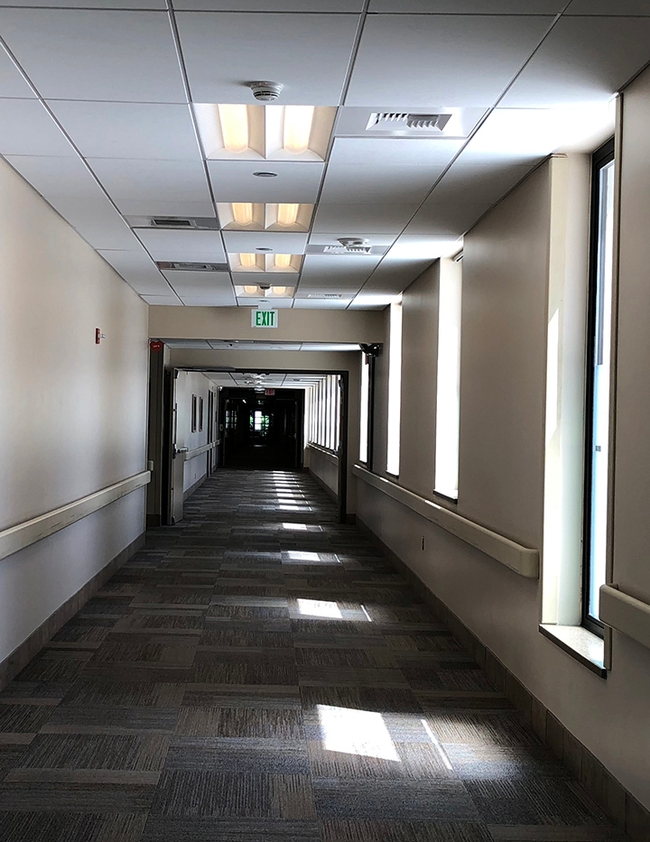
“TBI leads to a breakdown of the blood brain barrier,” said co-author Hammock, a member of the National Academy of Sciences and the National Academy of Inventors and whose pioneering work on sEH inhibitors spans 50 years. “We see from cases like Muhammad Ali that repeated TBI can lead to chronic central nervous system injury, dementia and other issues.”
“In the study from the Zhu laboratory, one of the exciting basic discoveries is that mammals have a natural mechanism to partially address traumatic brain injury,” said Hammock, who holds a joint appointment with the Department of Entomology and Nematology and the UC Davis Comprehensive Cancer Center. “By a mechanism under investigation, the injured brain communicates to the liver to down-regulate the production of an enzyme called the soluble epoxide hydrolase (sEH) that degrades natural inflammation resolving mediators. Thus, the concentration of these injury-resolving mediators also produced in the liver go up reducing deleterious inflammation throughout the injured animal. This soluble epoxide hydrolase inhibitor used as a tool in these studies is building on this natural mechanism to minimize the harmful effects of TBI.”
"Importantly, the soluble epoxide hydrolase inhibitor that the authors used here is also currently in human clinical safety trials for treating pain and inflammation,” said psychiatrist and neuroscientist Dr. Andrew Pieper, the Rebecca A. Barchas Professor in Translational Psychiatry, Case Western Reserve University, Cleveland. “The results shown here indicate that this agent, or related materials altering this same pathway, might mitigate the acute and long-term complications of TBI, or of neuroinflammatory conditions of the brain in general. Pieper, who holds both a Ph.D. and a M.D.. is the Morley-Mather Chair in Neuropsychiatry, University Hospitals of Cleveland Medical Center; director of the Brain Health Medicines Center, Harrington Discovery Institute; and psychiatrist at Louis Stokes Cleveland VA Medical Center, Cleveland.
Neuroscience researcher Daniela Kaufer, associate dean of biological sciences at UC Berkeley and a professor with the Department of Integrative Biology and Helen Wills Neuroscience Institute, praised the research possibilities. “The brain has a barrier which helps protect it from harmful materials in the blood,” said Kaufer, who was not involved in the research. “TBI reduces this barrier and its reduction is associated with aging. Possibly the pathway described in this PNAS paper could be manipulated to protect the blood brain barrier and reduce the apparent aging of the brain caused by repeated TBI.”
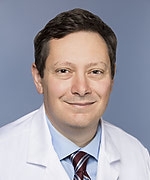
“My understanding of how we classify milds at UC Davis right now is that these are patients that behaviorally are mild injuries, but that they have something on a CT or MRI scan that indicates that the injury is more than a concussion, said Gurkoff, who was not involved in the research. “These patients are more likely to have long-term effects than concussion alone, but a lot less likely than moderate-severe. They also don't usually end up in the ICU. Then there are the concussions. Head injuries but no evidence of a radiological finding.”
“Add on top of that, repeat mild or repeat concussion,” Gurkoff said. “While some investigators will suggest that we have a good handle on repeat TBI--I still think it is the Wild West. It is clear that in a subset of humans, repeat TBI, even concussive, is catastrophic. Others seem to be fine. We also haven't dissected whether repeat TBI on its own is causal --or because many of the patients are in high risk/high stress situations--and it is the combination of TBI/repeat TBI with something else.”
“What gets me excited about certain compounds--Bruce's would be an example--is that if you have a low-risk compound, is it feasible that you give it to patients who might not develop long-term consequences?” Gurkoff asked. “For example, let's say a patient comes in and based on his injury and history, we might estimate there is a 10 percent chance he has a problem. You aren't going to schedule these patients for surgery--on the extreme--because the risk is too high given they most likely will recover. Having a low-risk compound that can be given to soldiers, athletes, etc, with mild or repeat mild--or concussion/repeat concussion--would be fantastic!”
The research drew financial support from the National Natural Science Foundation of China, Scientific and Technological Innovation, and partial support from Hammock's grants from the National Institute of Environmental Health Sciences' RIVER Award (Revolutionizing Innovative, Visionary Environmental Health Research) and the National Institute of Neurological Disorders and Stroke.
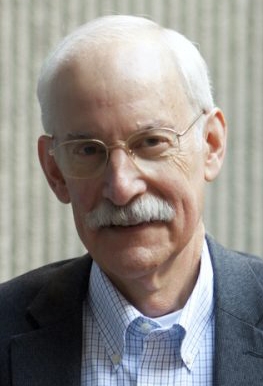
“This pioneering study provides clear evidence of the importance of liver-derived epoxy fatty acids (EpFAs) and reactive astrocytes from the immune system in protecting the brain from significant damage and post-traumatic dysfunction following percussive injury,” said William Schmidt, EicOsis vice president of clinical development. “As of now, there are no proven drug therapies that provide protective effects to the brain following single or repeated blows to the head from falls, auto accidents, or sports injuries.”
“The data from this study,” Schmidt said, “provides a pathway for developing inhibitors of sEH that, in turn, will enhance the availability of EpFAs circulating in blood to protect and restore the blood-brain barrier following TBI. I am hopeful that further preclinical studies will confirm these data and lead to a new type of drug therapy based on inhibitors of the sEH enzyme.”
“Clinical studies for TBI may still be a year or so away,” Schmidt added, “but EicOsis has an sEH inhibitor in early clinical development that may be suitable in the future for evaluation in patients with TBI.”
Hammock and colleague Sarjeet Gill co-discovered sEH in 1969 when they were researching insect developmental biology and green insecticides in the UC Berkeley lab of John Casida (1929-2018).
The enzyme is a key regulatory enzyme involved in the metabolism of fatty acids. It regulates a new class of natural chemical mediators, which in turn regulates inflammation, blood pressure and pain. The epoxy fatty acids control blood pressure, fibrosis, immunity, tissue growth, depression, pain, and inflammation, to name a few processes, Hammock said.
Resources:
PNAS paper: https://doi.org/10.1073/pnas.
Traumatic Brain Injury, National Institutes of Health
Traumatic Brain Injury, Mayo Clinic
Contacts:
Bruce Hammock, PhD: bdhammock@ucdavis.edu
Irene Cortés-Puch, M.D., EicOsis: icortespuch@eicosis.com

